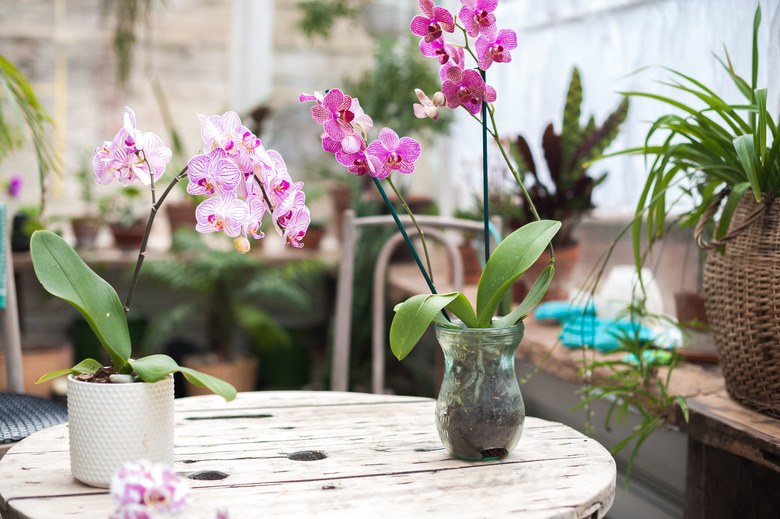How To Prune Orchids
We may receive a commission on purchases made from links.
Orchids are plants that belong to the family Orchidaceae. Many are air plants called epiphytes, which live attached to trees and other structures. They populate numerous genera and produce fragrant and exotic-looking blossoms, two facts that have given them the reputation for being prima donnas. A few can prove fussy, but most orchids are actually fairly hardy, and all varieties benefit from a little grooming. Some orchids are terrestrial plants, with their roots growing into the ground instead of attached to trees like many of their epiphytic orchid relatives. Pruning epiphytic (non-terrestrial) orchids will help to encourage flower rebloom and will also reduce the potential for disease.
If you are wondering how to prune orchid houseplants, you should know that it is relatively easy once you understand a few key principles.
When to Trim Orchids
When to Trim Orchids
Orchids are most frequently grown as houseplants, and they are beloved for their beautiful orchid flowers. Once flowers die, new flower spikes grow and produce new flowers. With proper orchid care, the plants will bloom for a surprising amount of time before the flowers become wilted. At some point after blooming, the plants go into a rest period. During this phase, the blooms will fall off the plants, leaving the orchid stems bare.
After the flowers bloom and fall, it's time to trim the orchids. But it is hard to predict exactly when that will occur. Both the bloom time and the bloom period depend on the type of orchid. There are over 25,000 different types of orchids, each with its own blooming cycle and season, even within the same genus.
For example, moth orchids also called phalaenopsis orchids (Phalaenopsis spp.) may bloom for three months or longer. Small flower buds grow on the orchid spike, producing multiple flowers. Some species are summer blooming, and some are winter blooming. Most will rebloom if properly pruned. Other popular orchid houseplants are dendrobium orchids, a very large genus with many species that have varied bloom cycles.
How to Prune Orchids After Bloom
How to Prune Orchids After Bloom
The first and most important reason to start pruning orchids is to encourage a rebloom. This task should be accomplished when the last flower on the orchid has wilted. In order to have new blooms, it is necessary to trim off the flowers where they join the flower stems, called the canes. Use clean, sharp garden shears, a knife, or even a razor blade to cut the flower spike. This encourages the plant to create new growth at the node, leading to more flowers in two to three months.
Here's how to trim an orchid properly:
- Look
for the nodes on the stem, which are bumps along the stem. - Cut the stem two
nodes above where it rises from the base of the plant. One of the nodes will
more than likely grow and produce flowers within the next two to three months. - Look
for the node on the stem that is just below the place where the flowers began
to bloom. - Make a clean cut at that juncture. The healthy green stem will have
the chance to bloom again.
Note that easy rebloomers, like the moth orchid, may flower again even if you don't prune the spike after the first bloom, but chances are the flowers will get smaller and the stem weaker.
What about the stems? Don't prune out the old canes until they've turned yellow since they will help with rebloom by storing nutrients and water.
How to Prune Orchid Keikis
How to Prune Orchid Keikis
Before pruning the faded flower stems and removing them from plants, examine them for small plantlets called "keikis." Not all orchids produce keikis, but phalaenopsis and dendrobium are two types that do, although this is only an occasional surprise and not a guaranteed occurrence on each flower stem. At first, you'll see tiny leaves at some point on the flower stem, which is your clue that a new plant is forming. The keiki will also develop roots while the baby plant is still attached to the flower stem. When the keiki has at least three leaves that are at least 2 inches long, and as many roots as leaves, you can prune it away from the mother plant by cutting the flower stem below the roots and potting the keiki it in its own container. Resist the urge to prune your keiki from the mother plant before these size guidelines, because it will not be strong enough to survive on its own if it's too small.
How to Prune Orchids for Health
How to Prune Orchids for Health
Pruning for a plant's health involves removing yellow leaves and flower stems as well as rotting roots. The flower stem, or cane, is the long, slender growth that rises from the thick orchid leaves. The buds form on this long green stem before blooming. An orchid's stems are healthy if they are green and firm. These should be left in place when the faded blooms are removed. However, if the stems are yellowish-brown, they may be rotted or diseased. Cut any discolored stems from the orchid as soon as you see them.
Similarly, rotting orchid roots should be removed. The greenish-gray aerial roots spread out above the ground from the base of the plant, running perpendicular to the oval leaves and stem of the orchid. If they begin to yellow and look withered, it can be root rot. Cut out these parts of the plant with a clean knife or pruner after the orchid blooms have fallen.
